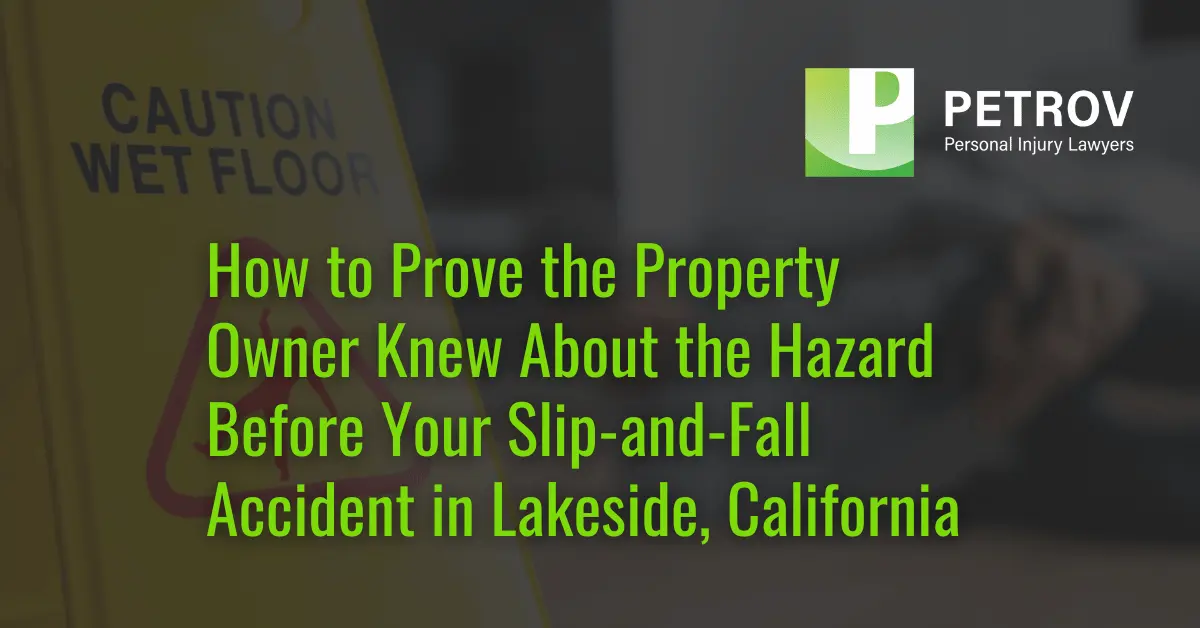Daniel Petrov | April 29, 2025 | Personal Injury

A sudden slip-and-fall can lead to painful injuries, time away from work, mounting medical bills, and lasting physical and emotional consequences. While accidents happen, not every fall is truly accidental. If a property owner failed to fix or even notice a dangerous condition, and you were hurt as a result, California law allows you to seek justice through a premises liability claim.
At Petrov Law Firm, our experienced attorneys, led by Daniel Petrov, have helped countless injury victims in Lakeside and throughout Southern California hold negligent property owners accountable.
If you’re wondering how to prove the property owner knew about the hazard before your slip-and-fall, this guide will walk you through the process and show you how we can help.
What Constitutes California Premises Liability Law?
In California, premises liability is governed under California Civil Code § 1714, which establishes that property owners owe a duty of care to maintain safe premises for guests, customers, and lawful visitors.
If a property owner fails to identify, fix, or provide a warning about a hazard and someone is injured as a result, they may be liable for the resulting damages.
To win your case, you must prove:
- The property was in a dangerous condition
- The owner knew or should have known about the hazard
- The hazard caused your injury
- You suffered real damages (e.g., medical expenses, lost wages, pain and suffering)
How to Prove the Owner Knew of the Hazard
Proving awareness is the cornerstone of any successful slip-and-fall case. Here are the most effective ways to demonstrate the owner knew, or should have known, of the danger:
1. Time Element
If the hazard was present for a long time before your fall, it strengthens your case. Surveillance footage, timestamped photos, and maintenance records can show how long the hazard was left unattended.
2. Foreseeability
If the hazard was obvious or recurring, the owner had a duty to anticipate and fix it. For instance, rainwater pooling at the entrance of a store during storms is predictable and should be managed proactively with floor mats or signage.
3. Witness Testimony
Eyewitnesses, such as other patrons or employees, can provide statements that the hazard existed well before your fall, or that the owner had been warned and failed to act.
4. Violation of Safety Codes
If the dangerous condition violates California Building Code standards or local ordinances, this can serve as strong evidence of negligence.
5. Maintenance and Inspection Logs
Some businesses keep cleaning schedules or safety inspection checklists. A lack of documentation showing that no inspections were done that day can help demonstrate the owner failed in their duty of care.
Under California’s comparative negligence law, you can still recover damages even if you were partially at fault. For example, if you were found 20% responsible for being distracted while walking, your total compensation would be reduced by 20%. Our team at Petrov Law Firm works hard to minimize unfair blame and protect your right to full recovery.
Common Slip-and-Fall Hazards That Lead to Injury
Slip-and-fall accidents often result from preventable hazards, including:
- Wet or greasy floors
- Uneven or cracked pavement
- Poor lighting in walkways
- Loose rugs or mats
- Spilled food or liquids in restaurants and stores
- Cords stretched across walkways
- Inadequate handrails on stairs
Property owners, especially in businesses open to the public, must routinely inspect and repair these hazards to prevent harm.
What Damages Can You Recover?
Slip-and-fall injuries can result in a range of damages. Depending on the case, you may be entitled to compensation for:
- Medical bills and ongoing treatment
- Lost wages and diminished earning potential
- Pain and suffering
- Emotional distress
- Permanent disability or disfigurement
Talk to an Experienced Slip-and-Fall Attorney at Petrov Law Firm Today
At Petrov Law Firm, we understand what you’re going through and are ready to help wherever you are in Southern California.
Contact us today for a free consultation. We’re here to help you take the next step toward justice and recovery.